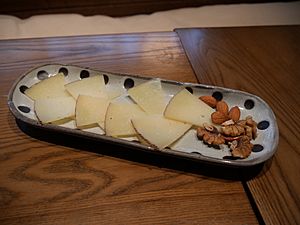Manchego facts for kids
Quick facts for kids Manchegoqueso manchego (Spanish) |
|
|---|---|
 |
|
| Country of origin | Spain |
| Region | La Mancha |
| Source of milk | Ewes |
| Texture | Firm and compact |
| Fat content | 6.5% min |
| Protein content | 4.5% min |
| Dimensions | max height 12 cm (4.7 in) max diameter 22 cm (8.7 in) |
| Weight | min 0.4 kg (0.88 lb), max 4.0 kg (8.8 lb) |
| Aging time | min 30 days, max 2 years |
| Certification | PDO |
Manchego (pronounced man-CHAY-go) is a famous cheese from Spain. It comes from the La Mancha region. This special cheese is made using milk from a specific type of sheep called the Manchega breed.
Manchego cheese is aged for a while, usually between 60 days and two years. It has a firm texture and feels a bit buttery. You might see small air pockets inside. The cheese itself can be white or a light yellow color. Its rind (the outside skin) is usually yellow or brownish.
This cheese has a unique flavor. It's rich and well-developed, but not too strong. It tastes creamy with a little bit of a tangy kick. After you eat it, you'll notice a taste that reminds you it's made from sheep's milk.
The name queso manchego (which means Manchego cheese in Spanish) is protected by law. This means only cheese made in a certain way, in a certain place, can use this name. It has a special status from the European Union called Protected Designation of Origin (PDO).
Contents
What Makes Manchego Cheese Special?
To be called queso manchego, the cheese must follow strict rules:
- It has to be made in specific parts of the La Mancha region in Spain. These areas include parts of the provinces of Albacete, Ciudad Real, Cuenca, and Toledo.
- The cheese can only be made from the whole milk of Manchega sheep. These sheep must live on special farms registered within the La Mancha area.
- It needs to be aged for at least 60 days. Smaller cheeses (under 1.5 kg) can be aged for a minimum of 30 days. The maximum aging time is two years.
- It must be pressed into a round, cylindrical shape. The cheese can be up to 12 cm tall and 22 cm wide.
Manchego cheese can be made from milk that has been pasteurized (heated to kill germs) or from raw milk. If it's made from raw milk, it might be called artesano, meaning "artisan" or handmade. The only things allowed to be added are natural rennet (which helps milk turn into cheese) and salt.
How Manchego Cheese is Made and Labeled
The molds used to press Manchego cheese give it its special barrel shape. Long ago, people used baskets made from woven esparto grass. This left a zig-zag pattern on the rind. Today, the molds have this pattern built in, so the cheese still gets the same cool design. The top and bottom of the cheese also have a design that looks like a head of wheat.
As the cheese ages, it forms a natural rind. This rind can be washed or coated with things like paraffin or olive oil. However, the rind must stay on the cheese if it's going to be sold as PDO Manchego.
Real PDO Manchego cheeses have a special casein tab. This tab is put on the cheese when it's still in the mold. They also have a unique label from the Manchego Cheese Council. This label says queso manchego, has a serial number, and shows a picture of Don Quixote de La Mancha.
Manchego is a very important cheese for Spain. Almost 60% of all Spanish cheeses with a special "Denomination of Origin" are Manchego. This makes it a key part of Spanish food. A lot of Manchego cheese is sent to other countries. This helps share Spanish food culture around the world. In 2017, La Mancha exported about 5.9 million kilograms of this cheese!
Different Types of Manchego Cheese
Manchego cheese comes in different flavors depending on how long it has aged:
- Fresco: This means "fresh" cheese. It's only aged for about two weeks. It has a rich but mild flavor. Because it's not aged much, it's not considered a true queso manchego. You usually only find this type in Spain.
- Semicurado: This is a "semicured" cheese. It's aged for 3 weeks to 3 or 4 months. It's a bit milder than the curado type.
- Curado: This is a "cured" cheese, aged for 3 to 6 months. It has a delicious caramel and nutty flavor.
- Viejo: This means "old" cheese. It's aged for 1 to 2 years. The longer it ages, the firmer and sharper its flavor becomes. It can have a rich, peppery taste. This type is great for grating or eating on its own. It's also popular for tapas, which are small Spanish snacks.
See also
 In Spanish: Queso manchego para niños
In Spanish: Queso manchego para niños

